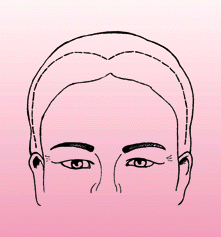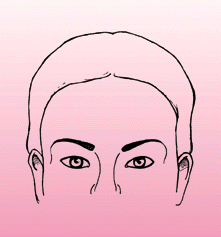 |
 |
The traditional face lift was designed to improve sagging tissues of the neck and jaw lines, whereas eyelid surgery would correct the upper face appearance only around the eye sockets. Neither dealt with vertical wrinkles between the brows or horizontal grooves on the forehead, particularly unsightly in females, giving them a worried or "tough" look. Fig. 22, Fig. 23; Fig. 36.
 |
 |
The forehead lift or upper face lift, with its various modifications, became popular in the late seventies. The incisions are usually hidden inside the hair line, although in some instances, may be placed along the hair line on the forehead. The skin of the forehead and eyebrows is lifted. The muscles responsible for creating forehead and between the eyebrow wrinkles are divided under the skin.
This operation has gained great popularity mainly because of the inconspicuous scars, relatively few side effects, and minimal immediate post-operative discomfort. It is frequently used for young females who have a habit of wrinkling their foreheads and whose low positioned eyebrows produce a sad and tired appearance. It is particularly effective in the older age group where sagging of the eyebrows produces hooding of the upper eyelids.
The operation is usually performed under local freezing with sedation. The patients are requested to shampoo their hair the night prior to their surgery. There is no shaving of the hair required. Some of the hair bearing skin will be removed during the operation unless the incision is placed along the hairline on the forehead when non hair bearing skin is removed. This latter technique is designed to prevent the tendency for post-operative lifting of the hairline.
Some of the hair will be cut during the surgery and will remain in the scalp to fall out during the first two hair washings after the operation. This should not alarm you as a sign of losing your hair. The incision is closed by metal staples which are removed between the seventh and twelfth day following the operation with less discomfort than suture removal. You can wash your hair on the third day, combing it gently with your fingers to avoid catching on the staples along the incision line. You should not dye your hair for three weeks after the surgery and therefore it is advisable to do it a few days prior to the operation.
 |
 | Figure 22a | Figure 22b |

 |  |
| Figure 23a | Figure 23b |

 |
| Figure 23c Ten Years After Surgery |

 |  |
| Figure 24a | Figure 24b |
